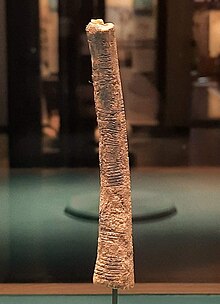
The Ishango bone, discovered at the "Fisherman Settlement" of Ishango in the Democratic Republic of the Congo, is a bone tool and possible mathematical device that dates to the Upper Paleolithic era.[1] The curved bone is dark brown in color, about 10 centimeters in length, and features a sharp piece of quartz affixed to one end, perhaps for engraving.[1] Because the bone has been narrowed, scraped, polished, and engraved to a certain extent, it is no longer possible to determine what animal the bone belonged to, although it is assumed to have been a mammal.[2]
The ordered engravings have led many to speculate the meaning behind these marks, including interpretations like mathematical significance or astrological relevance. It is thought by some to be a tally stick, as it features a series of what has been interpreted as tally marks carved in three columns running the length of the tool, though it has also been suggested that the scratches might have been to create a better grip on the handle or for some other non-mathematical reason. Others argue that the marks on the object are non-random and that it was likely a kind of counting tool and used to perform simple mathematical procedures.[3][4] Other speculations include the engravings on the bone serving as a lunar calendar. Dating to 20,000 years before present, it is regarded as the oldest mathematical tool to humankind,[1] with the possible exception of the approximately 40,000-year-old Lebombo bone from southern Africa.
- ^ a b c Huylebrouck, Dirk (2019), "Missing Link", Africa and Mathematics, Mathematics, Culture, and the Arts, Cham: Springer International Publishing, pp. 153–166, doi:10.1007/978-3-030-04037-6_9, ISBN 978-3-030-04036-9, S2CID 239306457, retrieved 2021-10-19
- ^ Association pour la diffusion de l'information archéologique/Royal Belgian Institute of Natural Sciences, Brussels (n.d.). "Have You Heard of Ishango?" (PDF). Natural Sciences.
- ^ Pletser, Vladimir (2012). "Does the Ishango Bone Indicate Knowledge of the Base 12? An Interpretation of a Prehistoric Discovery, the First Mathematical Tool of Humankind". arXiv:1204.1019 [math.HO].
- ^ Everett, Caleb (2017). Numbers and the Making of Us: Counting and the Course of Human Cultures. Harvard University Press. pp. 35–36. ISBN 9780674504431.